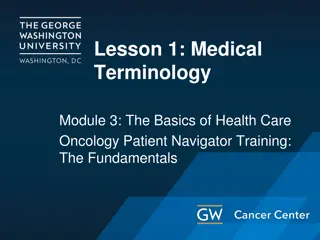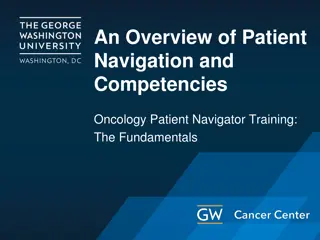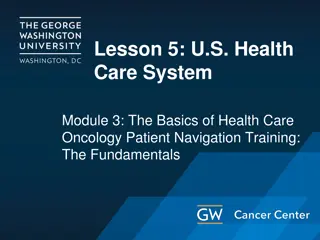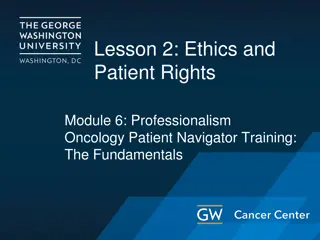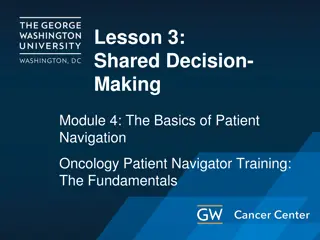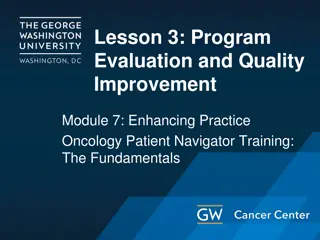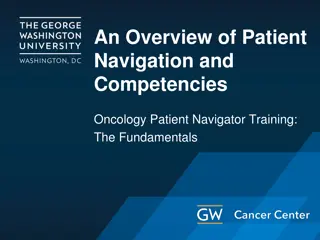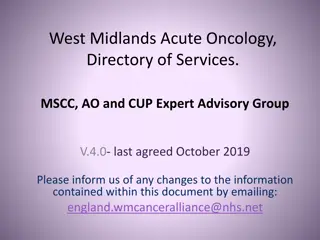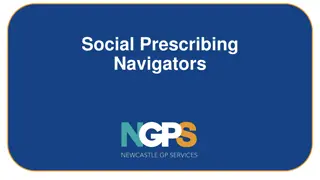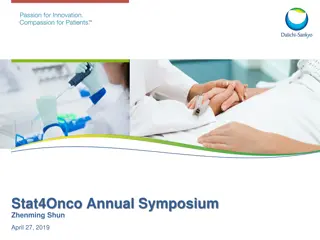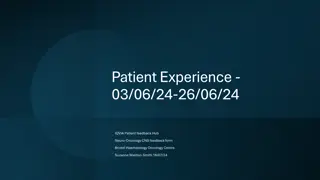Understanding the Role of Oncology Patient Navigators
This content delves into the essentials of patient navigation in oncology, covering competencies, professional roles, responsibilities, and functions of patient navigators. It highlights the importance of patient empowerment, communication, cultural competency, and care coordination. The material also touches on barriers to care, health disparities, and the various types of patient navigators.
Download Presentation

Please find below an Image/Link to download the presentation.
The content on the website is provided AS IS for your information and personal use only. It may not be sold, licensed, or shared on other websites without obtaining consent from the author. Download presentation by click this link. If you encounter any issues during the download, it is possible that the publisher has removed the file from their server.
E N D
Presentation Transcript
The Role of the Oncology Patient Navigator Module 4: The Basics of Patient Navigation Oncology Patient Navigator Training
Acknowledgments This work was supported by Cooperative Agreement #1U38DP004972-02 from the Centers for Disease Control and Prevention. Its contents are solely the responsibility of the authors and do not necessarily represent the official views of the Centers for Disease Control and Prevention. Portions of this lesson are adapted from the Patient Navigator Training Collaborative of the Colorado School of Public Health.
Competencies 5.4 Demonstrate responsiveness to patient needs within scope of practice and professional boundaries 6.1 Support a smooth transition of patients across screening, diagnosis, active treatment, survivorship and/or end-of-life care, working with the patient s clinical team
Learning Objectives Describe the role of the patient navigator Compare and contrast roles across patient navigator types
Navigator Functions Professional Roles and Responsibilities Barriers to Care/ Health Disparities Patient Empowerment Communication Community Resources Education, Prevention and Health Promotion Ethics and Professional Conduct Cultural Competency Outreach Care Coordination Psychosocial Support Services/ Assessment Advocacy Willis et al., 2013
Professional Roles and Responsibilities Community (Community Health Worker) Community/Health Care Institution (Patient Navigator) Health Care Institution (Nurse Navigator/ Social Work Navigator) General knowledge base on health issues such as diabetes, obesity, heart disease, stroke, HIV/AIDS and other chronic diseases. Knowledge of cancer screening, diagnosis, treatment, and survivorship and related physical, psychological, and social issues. Knowledge and maintenance of knowledge (e.g., license certification, continuing education) of cancer clinical impacts on patient, caregivers and families and ability to intervene (e.g., symptom management, assessment of functional status and psychosocial health). Active documentation in client record. Active documentation of encounter with patient, barriers to care, and resources or referrals to resolve barriers, which may be noted in the client record and/or the medical record. Conduct evaluation focused on community needs assessment and health behaviors. Active documentation in medical record. Conduct evaluation focused on barriers to care, health disparities and quality indicators. Conduct evaluation focused on clinical outcomes and quality indicators. Willis et al., 2013
Barriers to Care/Health Disparities Community (Community Health Worker) Community/Health Care Institution (Patient Navigator) Health Care Institution (Nurse Navigator/ Social Work Navigator) Address barriers to accessing the health care system. Address structural, cultural, social, emotional and administrative barriers to care. Address clinical and service delivery barriers to care. Focus on reduction of general health disparities. Provision of services to at-risk populations, which may be defined by individual need, high acuity or high volume at institutional level. Focus on reduction of cancer health disparities in medically underserved patients and timely access to care across the continuum. Willis et al., 2013
Community Resources Community (Community Health Worker) Community/Health Care Institution (Patient Navigator) Health Care Institution (Nurse Navigator/ Social Work Navigator) Provide referral to evidence-based health promotion programs. Provide assistance with scheduling appointments and facilitate request and follow-up with specialists or supportive care based on clinical referral. Focus on clinically oriented resources, such as referrals for second opinions, treatment or testing that may not be offered at the patient s institution, as well as supportive or specialty referrals within or external to the institution (Nurse Navigators). Provide assistance accessing health insurance. Provide assistance accessing health insurance, copay programs and financial assistance. Provide assistance in identifying community resources to access psychosocial support throughout treatment (Social Work Navigators). Willis et al., 2013
Patient Empowerment Community (Community Health Worker) Community/Health Care Institution (Patient Navigator) Health Care Institution (Nurse Navigator/ Social Work Navigator) Motivate individual and community to make positive changes in health behaviors. Assist patient with identifying administrative, structural, social and practical issues to participate in decision- making and solutions. Assist patients in decision-making regarding diagnostic testing and treatment options (Nurse Navigators). Activate and empower individuals and communities to self-advocate and make healthy decisions. Provide patients with strategies to cope with disease, treatment and stress (Social Work Navigators). Empower patients by ensuring they know all their options: identify their preferences and priorities, and assist them to access healthcare services and self-manage their health. Educate patients on their rights and preferences and ensure they are able to participate in the decision-making process throughout their care and into survivorship or end-of-life care. Educate patients on their rights and preferences and ensure they are able to participate in the decision-making process throughout their care and into survivorship or end-of-life care. Work in collaboration with licensed team members. Willis et al., 2013
Communication Community (Community Health Worker) Community/Health Care Institution (Patient Navigator) Health Care Institution (Nurse Navigator/ Social Work Navigator) Promote healthy behaviors Assist patient and provider with communicating expectations, needs and perspectives. Provide translation and communication of clinical information (Nurse Navigators). Facilitate communication with community about access and utilization of the health care system. Provide counseling through one-on-one communication and serve as a conduit between patient and providers to address emotional and psychosocial needs of patients (Social Workers). Willis et al., 2013
Education, Prevention and Health Promotion Community (Community Health Worker) Community/Health Care Institution (Patient Navigator) Health Care Institution (Nurse Navigator/ Social Work Navigator) Provide general health promotion at the individual and community level including: physical activity healthy eating habits stress reduction sunscreen use tobacco cessation reduction of other risky behaviors Educate patients on practical concerns and next steps in treatment with regard to what to expect. Assess educational needs of patient. Identify the educational needs of patients to advocate on their behalf with the care team. Identify the educational needs of patients to advocate on their behalf with the care team. Inform patients of the importance and benefit of clinical trials and connect them with additional resources. Inform patients of the importance and benefit of clinical trials and connect them with additional resources. Provide clinical education (Nurse Navigators). Willis et al., 2013
Ethics and Professional Conduct Community (Community Health Worker) Community/Health Care Institution (Patient Navigator) Health Care Institution (Nurse Navigator/ Social Work Navigator) Abide by state-defined scope of practice Understand differences in scope of practice between licensed professionals and non-licensed professionals Abide by the ethical principals in the profession s scope of practices and code of conduct according to licensure Willis et al., 2013
Cultural Competency Community (Community Health Worker) Community/Health Care Institution (Patient Navigator) Health Care Institution (Nurse Navigator/ Social Work Navigator) Act as community/cultural liaison and mediator between community and healthcare system using culturally appropriate educational materials. Provide navigation services in a culturally competent manner (e.g., National Culturally and Linguistically Appropriate Services [CLAS] Standards in Health and Health Care). Provide clinical care and education materials in culturally competent manner. Educate providers to increase their understanding of community s history, culture and needs. Willis et al., 2013
Outreach Community (Community Health Worker) Community/ Health Care Institution (Patient Navigator) Healthcare Institution (Nurse Navigator/ Social Work Navigator) Work with the community to identify education needs and opportunities. Educate on cancer-related topics to reduce fears and barriers related to cancer screening. Consult and counsel patients on their unique risks. Effectively link patients referred from the community to resources that can improve care coordination and timeliness to treatment. Willis et al., 2013; Johns Hopkins School of Nursing, n.d.; Community Toolbox, 2014
Checkpoint Mary is a patient navigator in urology. The urologist who works with Mary is very busy. He has a patient who has a lot of questions and does not seem to understand what the doctor is telling him. The urologist asked Mary to explain to the patient that he has prostate cancer and what his treatment options are. What should Mary do?
Care Coordination Community (Community Health Worker) Community/ Health Care Institution (Patient Navigator) Healthcare Institution (Nurse Navigator/ Social Work Navigator) Provide case management, service coordination, and system navigation. Identify the pathway in the continuum and document the next steps to ensure the patient s optimal outcomes. Assess and facilitate coordination of psychosocial and medical/clinical care along the care continuum. Assist with access to care or transition from community organization to health system. Identify unmet needs and facilitate cancer care resources to eliminate barriers along the cancer continuum. Willis et al., 2013; Agency for Healthcare Research and Quality, 2014
Psychosocial Support Services/ Assessment Healthcare Institution (Nurse Navigator/ Social Work Navigator) Community (Community Health Worker) Community/ Health Care Institution (Patient Navigator) Assess educational needs of patient. Identify the educational needs of patients to advocate on their behalf with the care team. Identify resources in the community for emotional and social support. Administer distress screening and provide assistance with administrative, practical or social issues identified. Inform patients of the importance and benefit of clinical trials and connect them with additional resources. Provide clinical education (Nurse Navigators). Educate patients and caregivers on their biopsychosocial concerns regarding their diagnosis and treatment (Social Work Navigators). Willis et al., 2013
Checkpoint Brenda is a patient navigator in radiology. A patient comes into her office and starts crying, telling Brenda that she was just diagnosed with breast cancer. Brenda tells the patient "I am so sorry for your news. We are all here to support you and will be with you every step of the way." The patient tells Brenda she is scared of going home because she does not want to tell her children. What should Brenda do?
Advocacy Community (Community Health Worker) Community/ Health Care Institution (Patient Navigator) Healthcare Institution (Nurse Navigator/ Social Work Navigator) Speak up for individual and community needs. Educate providers on individual preferences of care and needs. Assure patients needs and preferences are integrated into treatment and care delivery. Willis et al., 2013
Navigation Based on the Cancer Care Continuum Primary Prevention Screening/ Early Detection Treatment Survivorship Focus on healthy lifestyle/ disease prevention Remove barriers to screening and diagnosis Education, support, assist with care coordination, resource referrals Referrals for wellness/ nutrition, education, support groups and other services Hopkins & Mumber, 2009
What are Barriers to Care? Practical Personal Provider Psychosocial Systems
Practical Barriers to Care Insurance Work Transportation Food Insecurity
Personal Barriers to Care Provider mistrust Priority placed on health Health literacy Health beliefs
System Barriers to Care Care offered in one location Lack of interpreters Limited providers Appointment times
Provider Barriers to Care Communication skills Cultural dissonance Skills to provide affirming care Bias
Psychosocial Barriers to Care Support System Mental Wellbeing Stigma Anxiety
Navigator Duties Tasks Duties Parker et al., 2010
Categories of Navigator Tasks Navigating Facilitating Maintaining Systems Documenting and Receiving Information Other Parker et al., 2010
Navigator Tasks COACHING EXPLANATION ACTIVE LISTENING ASKING QUESTIONS Parker et al., 2010
Facilitating Tasks Finding Patients Coordinating Team Communication Integration of Information Collaboration Parker et al., 2010
Maintaining Systems Identifying potential patients Building networks and referral routines Reviewing cases Parker et al., 2010
Other Tasks Charting to track navigation activities Supporting research through administrative duties Filing papers Collaborating with Nurse Navigators (If applicable)
Navigation Network Duties Patient interactions Provider interactions Non-clinical staff Supportive services Paper or Electronic Medical Records
A Day in the Life of a Navigator Case 1 Case 2 Case 3 Call from patient who has surgery in 2 days. Patient would like to speak with anesthesiologist about nerve block. Patient also needs information about bras/garments she should wear after surgery. Newly diagnosed patient (68 year old, came alone). Patient currently finishing chemo, needs PET/CT. Has questions about survivorship clinic. Needs emotional support referrals. ACTION: Complete distress screening, assess barriers to care, help patient identify support; next step: BSG (refer to nurse to explain procedure). ACTION: Assist patient with scheduling procedure; discuss survivorship; assess patient for emotional distress and refer to appropriate resource ACTION: Mail patient information on camisole
A Day in the Life of a Navigator Case 4 Case 5 Case 6 Patient has concerns about 6 month follow-up screening plan given to her by doctor. She is supposed to have a mammogram, but one of her cancers was not visible on mammography. Patient calls with questions about radiation (has not been in for her consult yet). Newly diagnosed patient (mid-30s, has young children) comes in for first appointment. ACTION: Assist patient with scheduling appointment and give general information. ACTION: Complete distress screening, assess barriers to care, help identify support; assist in finding oncologist close to patient s home; give basic information about breast cancer and chemotherapy; refer to nurse to explain Mediport and tests needed before starting treatment. ACTION: Ask physician to clarify screening plan with patient: supply patient with correct order if needed and tell her how to schedule procedure(s).
A Day in the Life of a Navigator Case 7 Case 8 Case 9 Advanced stage patient experiencing pain and concerned about maintaining quality of life in end stages of disease. Patient beginning chemo needs her doctor to speak with surgeon ASAP regarding recommendations. Other doctor is going on vacation tomorrow. Patient applying for disability and Medicaid, needs referral to infectious disease, psychiatry. Needs PET/CT. ACTION: Fax MER form to PCP s office; task infectious disease administrative staff to call patient with appointment time; give patient number to schedule PET/CT; follow-up on psychiatry referral. ACTION: Refer to Social Worker and Nurse who refers to pain clinic. ACTION: Get doctor s direct phone number, track down surgeon, ask her to call doctor.
A Day in the Life of a Navigator Case 10 Case 11 Case 12 Patient planning mastectomy surgery, would like to speak with former patient who had the same procedure. Patient needs documentation for employer regarding her ability to work. Patient lives far away and would like a consult with radiation on the same day as her appointment with surgeon. ACTION: Create letter from surgeon to patient s employer; get letter signed & fax letter to patient s employer; scan letter to EMR. ACTION: Work with surgeon to identify former patient; contact former patient and ask if she would like to participate: contact current patient former patient s contact info. ACTION: Assist patient with scheduling appointment; call patient back with info.
A Day in the Life of a Navigator Case 14 Case 13 Referral from medical oncologist for patient to see dietitian. Patient needs appointment with physical therapist. ACTION: Call patient and set up time to meet with dietitian; add patient to dietitian s schedule. ACTION: Discuss role of rehabilitation clinic; schedule patient appointments.
The 5 As Ask Arrange Assess Assist Advise
Conclusion Describe the role of the Patient Navigator Compare and contrast roles across Patient Navigator types
References Agency for Healthcare Research and Quality. (2014). Care coordination measures atlas: Chapter 2: What is care coordination. 2014. http://www.ahrq.gov/professionals/prevention chronic care/improve/coordination/atlas2014/chapte r2.html. Bone, L. R., Edington, K., Rosenberg, J., Wenzel, J., Garza, M. A., Klein, C., Schmitt, L., & Ford, J. G. (2013). Building a navigation system to reduce cancer disparities among urban black older adults. Progress in Community Health Partnerships, 7(2):209 218. doi: 10.1353/cpr.2013.0018. Community Toolbox. (2014). Chapter 23: Modifying access, barriers, and opportunities. Section 6: Using Outreach to Increase Access. http://ctb.ku.edu/en/table of contents/implement/access barriers opportunities/outreach to increase access/main. Fiore, M. C., Bailey, W. C., Cohen, S. J., et al. (2000). Treating tobacco use and dependence. Clinical Practice Guideline. Rockville, MD: U.S. Department of Health and Human Services. Public Health Service. Hopkins, J., & Mumber, M. P. (2009). Patient navigation through the cancer care continuum: An overview. Journal of Oncology Practice, 5(4):150 152. doi: 10.1200/JOP.0943501.
References (Cont.) Johns Hopkins School of Nursing. (n.d.). Community outreach program. http://nursing.jhu.edu/excellence/community/outreach.html. National Cancer Institute. (2008). Cancer health disparities fact sheet. http://www.cancer.gov/aboutnci/organization/crchd/cancer health disparities fact sheet. Parker, V. A., Clark, J. A., Leyson, J., Calhoun, E., Carroll, J. K., Freund, K. M., & Battaglia, T. A. (2010). Patient navigation: Development of a protocol for describing what navigators do. Health Services Research, 45(2):514 531. doi: 10.1111/j.1475 6773.2009.01079.x. Patient Navigator Training Collaborative. (n.d.). http://patientnavigatortraining.org/. The Office of Minority Health. (2013). What is cultural competency. http://minorityhealth.hhs.gov/omh/browse.aspx?lvl=1&lvlid=6. Willis, A., Reed, E., Pratt Chapman, M., Kapp, H., Hatcher, E., Vaitones, V., Bires, J., Collins, S., & Washington, E-C. (2013). Development of a framework for patient navigation: Delineating roles across navigator types. Journal of Oncology Navigation & Survivorship,4(6):20 26. Retrieved April 15, 2021, from https://www.jons-online.com/issues/2013/december-2013-vol-4-no-6/1249- development-of-a-framework-for-patient-navigation-delineating-roles-across-navigator-types.
Thank you! Follow us on Twitter: @GWCancer www.gwcancercenter.org Sign-up for the GW Cancer Center s Patient Navigation and Survivorship E-Newsletter: bit.ly/PNSurvEnews Sign-up for the GW Cancer Center s Cancer Control Technical Assistance E-Newsletter: bit.ly/TAPenews






